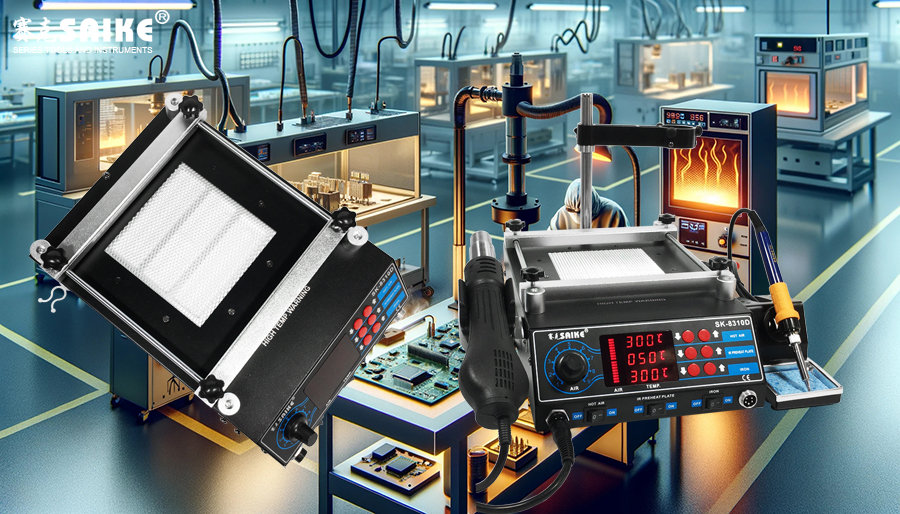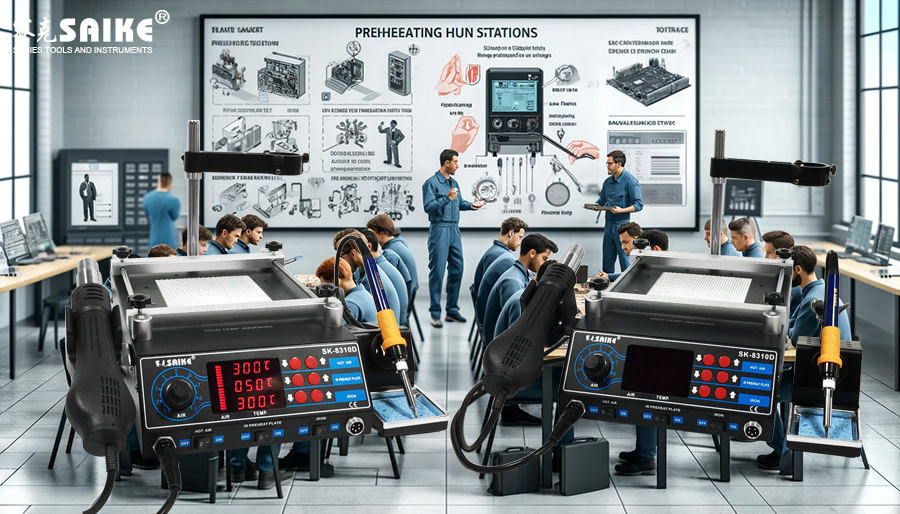
SK-YJ000YRT-KP 100003
In the field of electronic manufacturing and maintenance, the preheating station is a crucial device for improving soldering efficiency and quality. The right choice of preheating station not only ensures a smooth soldering process but also prevents component damage caused by improper heating. This article will detail the different types of preheating stations and the criteria for selecting a suitable one.
I. Types of Preheating Stations
Preheating stations come in various designs and functions, primarily categorized into the following types:
1.Infrared Preheating Station
– Working Principle: Uses infrared radiation to directly heat objects. Infrared rays can penetrate deep into components, providing fast and uniform heating.
– Advantages: Fast heating speed, able to deeply heat complex component interiors, suitable for large or thick circuit boards.
– Disadvantages: Temperature control is not as precise as contact or hot air preheating stations, and there’s a risk of thermal damage to exposed sensitive components.
2.Hot Air Preheating Station
– Working Principle: Heats the circuit board through hot air. The temperature and flow rate of the hot air can be precisely controlled, suitable for applications requiring localized heating.
– Advantages: Provides uniform heating, with easy control over temperature and air speed, ideal for temperature-sensitive electronic components.
– Disadvantages: Limited heating area, which may require longer heating times for large circuit boards.
3.Electric Heating Wire Preheating Station
– Working Principle: Uses electric heating wires to heat the air or metal plate, which then transfers heat to the circuit board through conduction.
– Advantages: Simple equipment structure and lower cost, suitable for small-scale operations with limited budgets.
– Disadvantages: Slow temperature rise, relatively low temperature uniformity, and control precision.
II. Selection Criteria
Choosing a suitable preheating station involves considering several key factors:
1.Heating Method: Select the appropriate heating method based on the characteristics of the soldering material and the structure of the circuit board. For instance, infrared preheating stations might be more suitable for multi-layer thick circuit boards or boards containing a significant amount of metal.
2.Temperature Range and Control Precision: The preheating station should provide a sufficient temperature range to accommodate the melting points of different solders. Additionally, precise temperature control is crucial for protecting sensitive components.
3.Board Size and Shape Adaptability: Consider whether the effective heating area of the preheating station can cover the entire circuit board or specific work areas. For irregularly shaped boards, hot air preheating stations might offer higher flexibility.
4.Energy Consumption and Efficiency: Take into account the energy consumption and operational efficiency of the equipment. More efficient preheating stations can shorten work cycles and conserve energy, especially in large-scale production.
5.User Interface and Operational Convenience: Modern preheating stations often come with digital control panels and programmable features that can significantly simplify the operation process and enhance work efficiency.
6.Safety: Ensure that the preheating station incorporates necessary safety measures, such as overheat protection and automatic shutdown functions, to prevent accidents during operation.
III. Conclusion
Selecting the right preheating station is vital for ensuring high-quality electronic manufacturing and maintenance work. By carefully considering the type of preheating station, heating method, temperature control capabilities, and other crucial factors, one can significantly improve the quality and efficiency of the soldering process. As electronic technology continues to advance, the functions and performance of preheating stations are constantly improving. Choosing updated and more advanced equipment can help businesses stay at the forefront of technology and better meet market demands.


